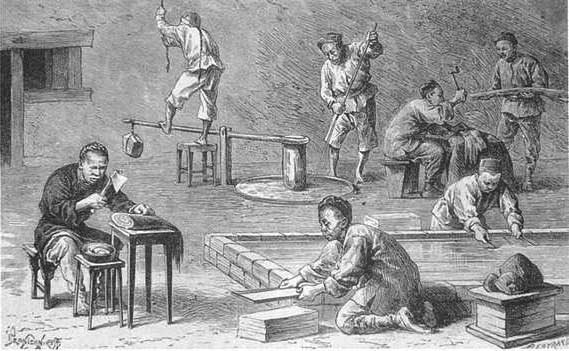

The history of science and technology in China is both long and rich with many contributions to science and technology. In antiquity, independently of Greek philosophers and other civilizations, ancient Chinese philosophers made significant advances in science, technology, mathematics, and astronomy. The first recorded observations of comets, solar eclipses, and supernovae were made in China. Traditional Chinese medicine, acupuncture and herbal medicine were also practiced.
Among the earliest inventions were the abacus, the "shadow clock," and the first flying machines such as kites and Kongming lanterns. The four Great Inventions of ancient China: the compass, gunpowder, papermaking, and printing, were among the most important technological advances, only known in Europe by the end of the Middle Ages. The Tang Dynasty (AD 618 - 906) in particular, was a time of great innovation. A good deal of exchange occurred between Western and Chinese discoveries up to the Qing Dynasty.
The Jesuit China missions of the 16th and 17th centuries introduced Western science and astronomy, then undergoing its own revolution, to China, and knowledge of Chinese technology was brought to Europe. Much of the early Western work in the history of science in China was done by Joseph Needham.
Alchemy Alchemy was Taoist chemistry, very different from modern chemistry.
Anesthetic - third century found a wine that acted like anesthetic, and they also used herbs before the age of written history
Astronomy - Planetarium - They produced the first planetarium, which was actually made by an emperor. The planetarium was a big enclosed place with stars and constellations on the inside. The person using the planetarium would sit in a chair that was hanging from the top of the enclosed dome.
Astrology - Chinese astrology and constellations were often used for divination
Bamboo - They made most toys, machines, houses, and other things from bamboo.
Blast Furnace - which was water powered
Block Printmaking / Printing Technology
Clocks - The first clock that they devised was for astronomical uses. In the first clock ever, there was a puppet that would hold up a plaque that would tell the time. They also invented giant water clocks, which rang every fifteen minutes.

Compass - was for religious use. When a new houses was being built, the used it to see if the house was faced in perfect harmony with nature (which meant they thought if you faced your house to magnetic north, you and nature would get along). The compass started out as a wooden circle with markings on it, and a magnetic spoon on top.
Crossbow
Earthquakes - Designed with a machine called the Earthquake weathercock, which was a contraption that told them when and where an earthquake would come. This machine looked like a giant six-foot bronze pot that had dragon heads lining the top, and ivory frogs under each dragon.
Fan - which was mostly carried by women and soldiers. Most of the fans were made out of bamboo and silk. The fan was basically many bamboo spines sticking out in almost a half circle with silk wrapped around it.
Fireworks - invented in the T'ang dynasty. These were originally for shows, but later on they used them to scare of enemies in war. The fireworks were mainly small bamboo cases filled with gunpowder, and a fuse was put on the side.
Glider
Harness - revolutionized agriculture by harnessing animals
Hot Air Balloon
Iron casting around the sixth century, when they mixed tin and copper together.
Kites - which mostly children played with. The kites were most of the time silk squares, held together by bamboo. Created many things with bamboo, which made a lot of baskets and holders and were really strong.
Lacquer
Mathematics - They invented the Asian Abacus. The main applications of mathematics in traditional China were architecture and geography. Pi was calculated by 5th century mathematician Zu Chongzhi to the seventh digit. The decimal system was used in China as early as 14 Century BC. "Pascal's" Triangle was discovered by mathematician Liu Ju-Hsieh, long before Pascal was born.
Military Inventions
Military innovations include the crossbow and the grid sight, crossbow stirrup, repeating crossbows, poison gas (smoke from burning dried mustard), tear gas made from powdered lime, relief maps for battle planning, manned kites, fire lance, rockets, gunpowder incendiaries, gunpowder grenades, proto-handguns, various gun-related ammunition types and the cannon.
Gunpowder - In the T'ang dynasty gunpowder was accidentally invented in an attempt to make the elixir of life, to make the emperor immortal. Cannon - were just bamboo cases holding gunpowder and were put in a big iron cannon. Bamboo or iron basket, which was like a smaller version of the cannon, that had arrows with rockets attached to them. The arrow rockets would shoot out of the miniature cannon like bullets out of a gun wood.
The nest cart was a mobile lookout, for oncoming armies and other things. The people in the nest cart also dropped bombs from their perch, which was perfect because they had a bird's eye view.
The first to make bombs for war, in the 17th Century, which were no more then a bamboo shell, about the thickness of two men's legs, and the length of a man's leg. The bombs were then filled with gunpowder, and a fuse like the fireworks, was installed.
Paper
Porcelain
Rudder
Seismograph
Silk - first harvest silk, and make clothes, fans, kites, toys, paper, and lots of other things from it.
Spaghetti
Stirrup
Wheelbarrow - Invented in the Han dynasty and used for carrying loads too heavy for a normal person's back to support. The wheelbarrow was originally wood, so the Chinese nick named it the 'wooden ox'.
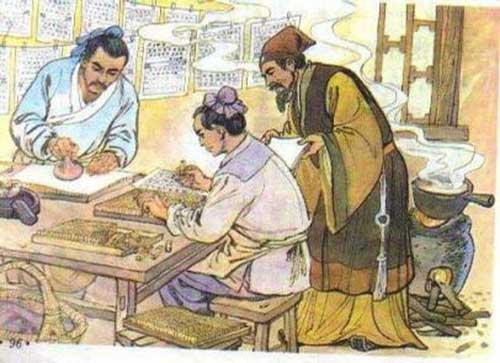
Ancient Chinese were the first to invent paper and printing. Their early script contained 80,000 different characters.
They went on to invent books and had book shops in every city by the end of the T'ang dynasty.
There were 3 different important kinds of paper, the very first being silk rags. The cheap kinds were no more the wooden strips, and the most expensive was silk cloth. Although most of the kinds of paper was made from over 50%bamboo, some of the other things they were made of were silk, cloth, hemp, mulberry bark, and plant fibers.
In the Han dynasty, 206B.C.-A.D.220, paper and ink were invented.
In the T'ang dynasty, 618-906, the first printer was invented. In 868 AD the earliest known book ever was printed.
About 1,800 years ago, during the Eastern Han Dynasty (25-220), Cai Lun improved China's papermaking technique using bark and hemp. This then became one of the four great ancient inventions of Chin. Today, ancient papermaking has been replaced by modern means of production, but in some places in southwestern China's Guizhou Province, where many people of ethnic-minority groups live; this ancient technique is still practiced.
In Huishui, Changshun and Danzhai near Guiyang, capital of Guizhou, many papermaking workshops are well preserved. Of them, the biggest is the one in Dongkou Village, Lushan Town, Huishui County, some 80 kilometers south of Guiyang.
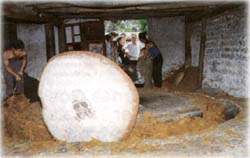
Stone roller grinding fermented and boiled bamboo
At Dongkou Village, where Bouyei people live, we can see an open dam through which a limpid river flows, and flocks of ducks are seen sporting and playing in it. On the banks Bouyei women in groups of two and three wash clothes. All Are quiet, leisurely and carefree.
Looking down from a high place, we can wee large and small steaming and boiling kilns, fermenting pools and lime pits scattered all over like stars in the sky, as if to tell and sing a story of long, long ago. Near high and low thatched cottages are papermaking workshops and a water-powered mill wheel.
The local records say that the papermaking industry there began 300 years ago, in the late Ming and early Qing dynasties. Later it flourished during Qing emperor Qian Long's reign(1736-1796), and the number of papermaking households increased from three to a dozen. Every household had eight kilns, with a monthly rough-straw paper (or toilet paper) output of 150 kg. At that time, hand production included husking bamboo and hemp with pestles and mortars. Today, such primitive means of production can still be seen in Xieyao Village, Changshun, 30 kilometers from Huishui.
In the early 20th century, Dongkou's paper making industry spread to more than 100 households. The husking of bamboo and hemp was then done by water- or ox-powered roller. In the 1940s, paper making there became more flourishing, and production spread to 150 households, with a total of 300 kilns. The number of paper making workshops grew to 180, grinding 1.5 million kilograms of bamboo raw materials a year with 60 rollers. Its annual output was 0.5 million tons of rough-straw paper. Today, both rough-straw paper and paper money are good sellers in all corners of the province.
To make rough-straw paper takes two kinds of bamboo as raw materials, with the addition of birch leaves, lime and water. Generally, the paper, called zhuma (bamboo hemp), is clean and is a good absorbent. One special use is for putting under corpses.
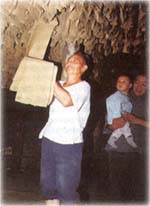
Collected dried paper
Birch leaves are necessary materials for paper making. The mucilage is drained out of the leaves for strengthening the adhesion of the paper, and for improving its smoothness and evenness. First, bamboo is husked with a pestle and mortar. It is then placed in a pool of lime to soak for several days to make it soft. It is then put into a big kiln for steaming and boiling for 35 days. After being rinsed in river water, it is again steamed and boiled for another ten days before being ground into pieces and put into a pool of pure water. After mucilage from birch leaves has been added, it is then strained. The residue is the pulp raw material.
Originally, papermakers used bamboo curtains to hang the sheets of pulp on till they dried to the constituency of damp paper. Later, the remaining water was squeezed out.
Invented origami - which originated with the wealthy people in China - when they used expensive paper to write to friends. Before they sent the letters, they folded them up into fancy designs.
They also modified paper to make raincoats, windows, umbrellas, they used a lot of paper in their houses even windows!
Many of the children's toys were made out of paper.
Armor for war was made from strengthened paper.
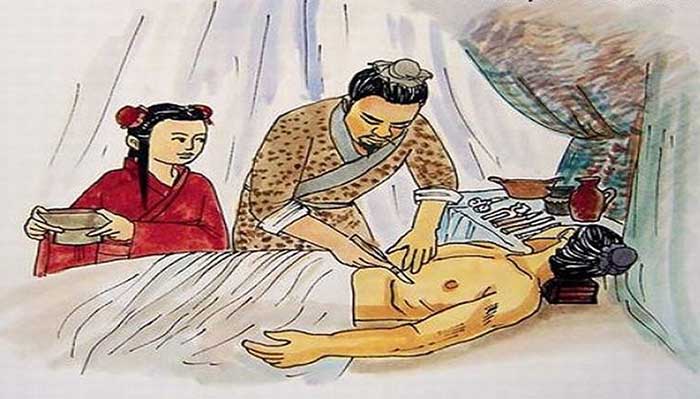
Ancient studies in biology have been extensive, and historic records are consulted even today, such as pharmacopoeias of medicinal plants. Traditional medicine and surgery were highly advanced at various points in history, and in some fields are still seen as innovative. They continue to play a growing role in the international medical community, and have achieved recognition over the last few decades in the West as alternative and complementary therapies. An example is acupuncture, although it is somewhat controversial in some quarters. However, autopsy was unacceptable, because of the common belief that a corpse should not be violated. Nevertheless, there were several doctors who have increased the understanding of internal anatomy by violating this autopsy taboo.
The Chinese had many natural remedies some of which included natural herbs and acupuncture.
The discovery of medicine in ancient China started more than 2,000 years ago. In Ancient China, the Chinese's goal to make medicine was to make an elixir of life to make emperors immortal and help them live eternally. Eventually, in their quest to make an elixir of life, they made series of medicines and remedies. That is how China began the search for medicine.
An elixir of life is a potion that the Chinese believed would make you live forever. The Chinese believed that this liquid potion was made from the gods, and whoever drank it would be rewarded with eternity, which means you would live forever. The Chinese wanted to try to make an elixir because they wanted to make the emperors immortal. That is why the ancient Chinese tried to discover a potion that would make you eternal.
The idea to discover an elixir and the science of medicine was influenced by Tao Ch'ien, a famous poet and philosopher.
In his poetry and philosophy, he believed that if the Chinese discovered a method of turning metal into gold, which would last forever, they would at the same time discover the elixir of life. With this belief, doctors and pharmacologists began to search madly for a technique to make metal into gold. This belief also made doctors try to discover other ways to make people immortal, and that led to the making of the elixir.
After creating many medicines (such as herbal medicines like an Euryale seed which treated urination problems and animal organs, like the pig's liver, that helped someone's eyesight) which were discovered during the rush to make an elixir of life, Tsou Yen, a pharmacologist, formed a theory on how he thought diseases were caused. He believed two spirit-like life forces called Yin and Yang flowed through the body. He said that diseases were thought to be caused when either Yin or Yang were out of balance. After his belief was spread, many doctors in China tried to make a way to make the Yin and Yang balanced inside the body. This was when a pretty famous treatment was made, which is still used today.
About a century after the discovery of medicine, acupuncture was invented in China. Acupuncture is a treatment, which doesn't involve any drugs. Needles are put in certain parts of the person's body. The Chinese believed that if you put the needles in those specific spots, Yin and Yang would be balanced. When the forces were balanced, it was believed to relieve your pain and you wouldn't get any diseases. That treatment was the most commonly used one at the time.
Later in the years, Chinese medicine was becoming a little bit more advanced. Once again, Tsou Yen turned medicine-making into a science. He wrote theories about elements, and he made a system of rules of classifying large and small objects. Shen Nong then put herbal medicine in two categories: "Four Spirits" and "Five Tastes". Shen thought that if drugs or any other medicines that made your body respond to either cold, hot, warm, or cool, they would go in the "Four Spirits" group. If a medicine is sour, bitter, hot, sweet, or salty when it was tasted, it would be in the "Five Tastes" group.
These discoveries and events led to the invention of medicine. If the Chinese did not discover medicine, today's doctors would not have such advanced medicine we have today. The modern world has benefited on the inventions and discoveries made by China.
One of the most famous doctors was Tao Chi'en. He was the first to influence doctors to make a study of elixirs. He was also the one to pass the belief that if the Chinese discovered a method to make metal into gold, they would at the same time discover the elixir of life. With this belief, Li Shao-Chun was the first to make an attempt on making a metal to gold.
Li Shao-Chun was the first doctor, or pharmacologist, mentioned in early Chinese records. He was the one to pass a belief that gold made from a red metal called cinnabar could make a person immortal. He said if a man ate from dishes made from that gold, the man would be rewarded with eternal life by the goddess, Spirit of the Furnace. This belief of his was influenced by Tao Chi'en's thought. Soon many doctors spread many theories about making gold for the emperors.
A poet named Ko Hung organized most of the beliefs about making the immortal gold in a book. In his book, he also put formulas for making elixirs of life. Ko was the first to put all the methods of turning metal into gold and all the ways of making elixirs into a book.
Later in the years, people believed that doctors could bring people back to life. The people thought this because a famous doctor named Bian Que had brought a prince "back to life" in the year 201 B.C.
This happened when he went to the state called Guo, and he saw a funeral of a prince going on in the state. The prince was dead for half the day, but Bian Que went to the body and did acupuncture on the prince's wrists and thighs. He also gave the prince many drugs and herbs. Soon, the prince came out of his coma and he was alive again!!!! The people were so amazed that Bian Que was named the Shaman of Life!
In 100 B.C., Shen Nong invented the first set of herbal medicines. He had made a graph full of herbs and their uses. He also showed a lot of doctors how the herbal medicine was made. With this discovered, Tao Hung Ching put all of Shen Nong's knowledge of herbs into a book. Herbal medicine had been invented in 100 B.C..
In Hong Kong, Alexander Yersin discovered the first identified parasite in China called the Yersinia Pestis. A parasite is a tiny little germ that you cannot see, but it could enter your skin and cause disease. This parasite was found in most of the diseases in China such as Malaria which is when a mosquito injects some sickening juice in you skin. After finding a parasite, many Chinese doctors developed a series of remedies to stop this parasite. This was the first parasite discovered in China.
Li Shizen was a famous pharmacologist noted in Chinese records, too. He traveled through China to find every medical achievement there was. He then summarized them from his time, and he listed the 1,892 herbs and listed the 11,000 prescriptions in a book. He also corrected mistakes in some medicine uses and he classified all the herbs used in medicine.
There were many interesting ways to make medicine in ancient China. The ingredients for China's unique medicines were mostly herbs. Of course, there were no supermarkets and malls to go to buy the things for medicine. So, to get the stuff for medicine, most doctors had to get their herbs from a farmer, or some doctors grew their herbs by themselves. But the long process to make remedies was very exhausting. The first step for making the ancient medicine was to grow the herbs in the fields of China.
The Chinese had learned how to grow herbs and raise animals 4,000 years ago. The Chinese grew their herbs in mountainous terrains and narrow terraces, which are grassy fields that have a series of banks. In the terrains, they grew their herbs in a rich, yellow soil called loess. It was said that loess was blown in from the Mongolian Desert. To cut the herbs from the fields, they used a wooden knife, called a Leem, to cut the weeds. After getting the herbs, the herbs were given to the doctors. That was how the doctors got the herbs. The herbs were dried by the sun. The herbs were left there for a couple of hours. After it was dried, it was then soaked in cold water. Next, the doctor or pharmacologist took the herb and he/she mashed the herb into a powder with a wooden cylinder bar. After that, they took the powder and mixed it with some water and stirred it to form a liquid. After this procedure, the herbal medicine is done. Some of the liquidized herbs were potable, but other herbs were rubbed on your skin if you had skin disease and fractured bones. That was how they made some of the herbal medicines.
Not all medicines were herbs. Some of them used animal organs or animal parts. To get the organs, the doctors cut the animal with a bronze knife. They took out the organs that were good for sicknesses, such as a sheep's eye. The organs or parts were cleaned in water, then the parts were given to patients for them to eat so that patient could be cured. The rest of the body of the animal was dried and stretched on a stick. To eat it, the people had to boil it in water.
In Ancient times, the Chinese believed that two dragon spirits could be in your heart. They were the black dragon, and the white dragon. The black dragon spirit represented bad luck and evil. The white dragon spirit represented eternity and good luck. Each spirit was believed to be in a person's heart, and either the black or white one lived in your heart. In order to know if you either have the white or black dragon spirit in you, a doctor has to inspect your tongue.
The Chinese believed if your tongue's color was yellow, it would mean that fire from the dragon has risen in your stomach. If your tongue has a purple color, that means that your heart is pumping unhealthy blood. If you had a yellow or a purple tongue, the Chinese believed that you would have the black dragon spirit. You would have the white dragon spirit if you had a healthy red tongue. This was one of Ancient China's religious beliefs, and with this belief, the Chinese doctors discovered a way to rid the black dragon spirit. It is called the heat treatment.
The heat treatment was another treatment used in ancient China. For this process, a doctor places a needle in your skin, and the doctor burns mugwort, an herb. The heat from the burning mugwort is carried through the needle and into the body. This was supposed to relax your mind and to excite your spirit. If you had the black dragon spirit in you, the Chinese believed the heat treatment could make it go away.
In Ancient China, there were people who had a lot of sicknesses and diseases such as skin disease, urination problems, chicken pox, and lack of energy. To get treated, these people had to go to the village doctor. If you went there and you had asthma or you were depressed, the doctor would cure it by letting you eat some ginseng weed, which is an herb.
There were many other medicines that helped the people. If you had skin problems, the medicine the ancient Chinese would give you to eat would be dried sea horse. If you were a man and you thought you needed more energy in your sex life then the ancient Chinese would give you some dried gecko for you to cook and eat. There were many other medicines that had numerous nutrients and minerals such as the cow stomach which has a lot of iron in it, or the sheep's eye which has many vitamins in it.
History of Traditional Chinese Medicine
History of science and technology in China